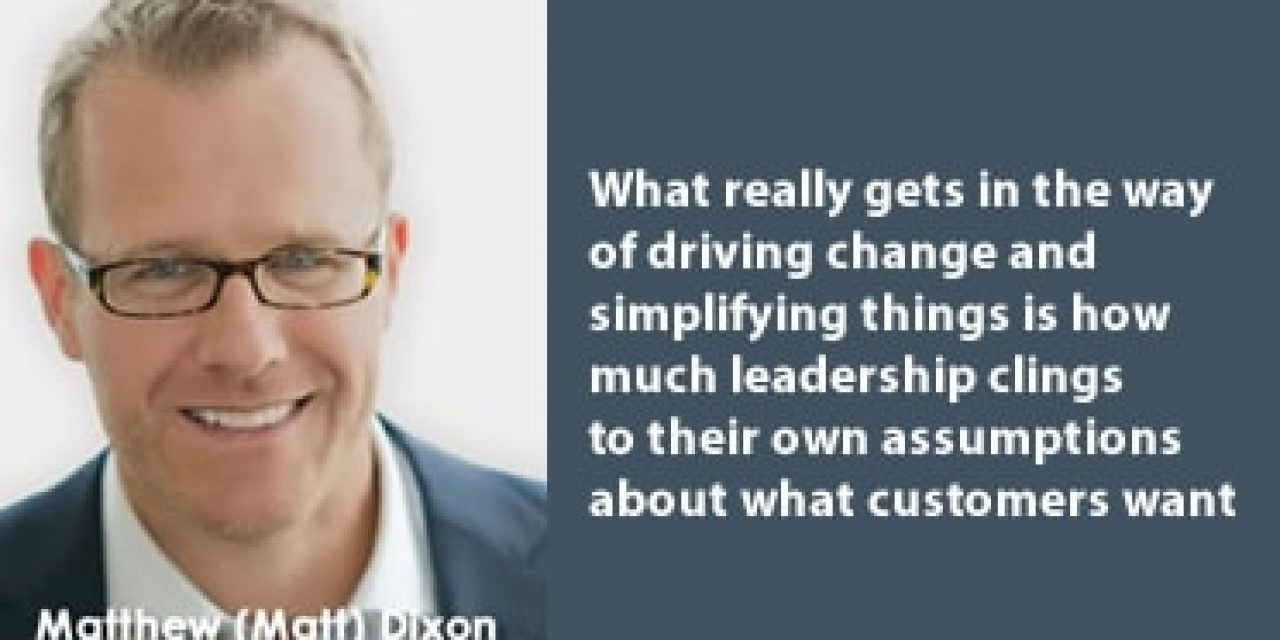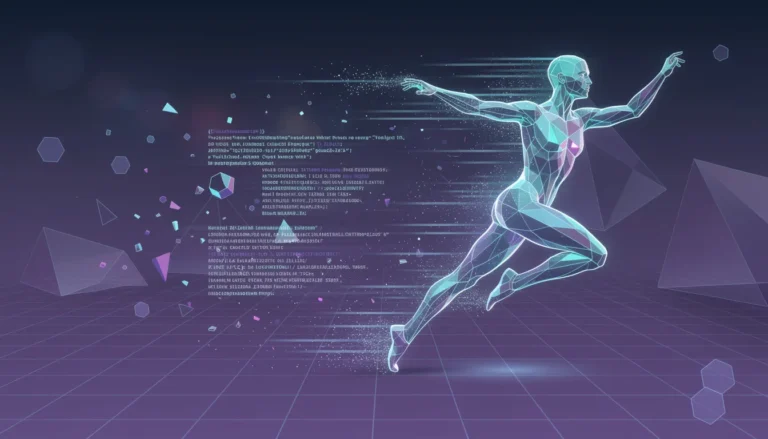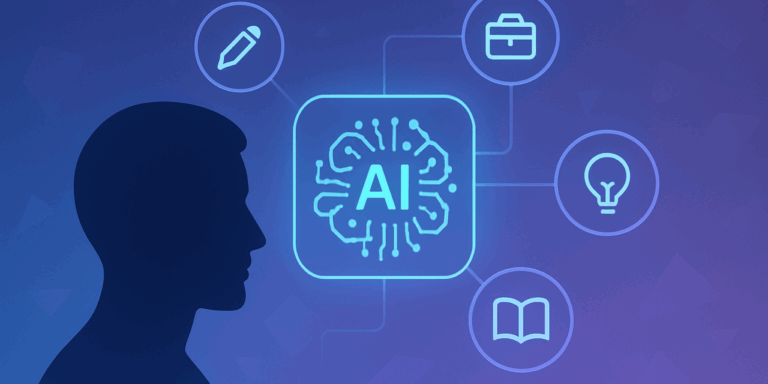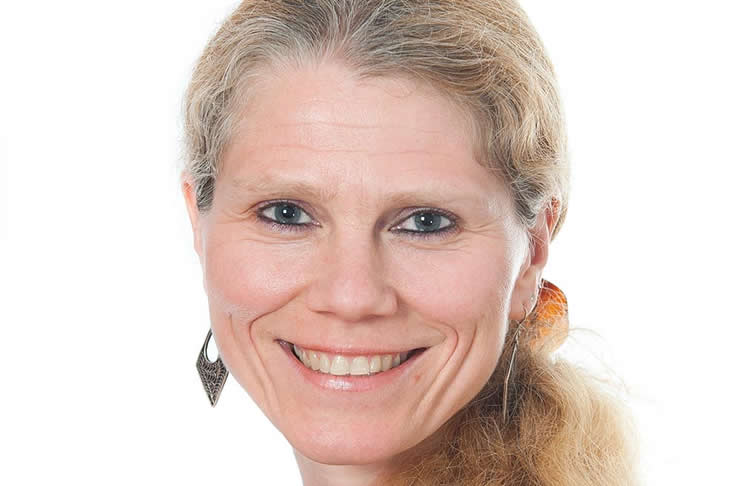
Matthew – Matt – Dixon is Group Leader, Financial Services and Customer Contact Practices at CEB (Corporate Executive Board). If that doesn’t ring a bell: Matt also wrote “The Challenger Sale: Taking Control of the Customer Conversation” and “The Effortless Experience: Conquering the New Battleground for Customer Loyalty”.
Effortless (customer) experience, customer loyalty, the Customer Effort Score and the often surprising human elements and stumbling blocks in becoming a low effort organization. Matthew Dixon tackles it all in this interview.
Being easier to do business with: a tsunami of improvement opportunities
Since you wrote The Effortless Experience and the well-known CEB research on the key role of effortlessness was published it seems that the focus on making things easier for customers is growing. A few years ago usability, Web and digital marketing expert Gerry McGovern said in an interview ‘Ease of use is a tsunami ripping across the world‘. Do you see this tsunami and are organizations reacting to a new reality where simple seems to be the new black or is it still too much lip service?
Matthew Dixon: I wish I came up with that phrase! You know, I do think that this idea of being easy to do business with has really picked up steam in the business world. If I think back to when the book first came out, we were presenting our content largely to contact center leaders and their teams. Today, we’re being invited to present to management committees and senior executives across the enterprise. So, there’s this realization that, right now, our companies really aren’t very easy to engage with for our customers and we need to do something about it. Now, how much of that is lip service, is hard to say.
As we tell our clients, when it comes to being easier to do business with for your customers, there is “food for many winters”—in other words, there’s no real shortage of improvement opportunities. I like to think that recognizing this is an issue—at the highest levels of an organization—is an indicator that companies will start investing real resources and start focusing on this work. But, as a consumer, it does feel like those improvements have been slow to materialize. Dealing with your average large company today feels remarkably similar to the experience of five or even ten years ago in most cases.
Does customer loyalty still exist? A matter of context
Customer satisfaction doesn’t lead to customer loyalty is one of the, for many counterintuitive, takeaways of your research and book. Today, it seems more people even start doubting the value and reality of customer loyalty as such. What are your thoughts on this? How can we “make” customers loyal in times they decreasingly are? How do we go beyond the loyalty card that in practice turns out to be a simple rebate card?
Matthew Dixon: It’s a fascinating question, really. What is loyalty? Does it exist or is what we construe to be “loyalty” merely captivity? I guess I’m an optimist here and would argue that there is such a thing as loyalty and truly loyal customers—the ones who willingly buy again and again, who open their wallets when new products and services are introduced, who go out of their way to say good things to others about a company.
Do we mistake captivity for loyalty? Sure, but it doesn’t mean that each company doesn’t have a core set of truly loyal customers, those who do business with us because they want to, not merely because they have to. I do think, however, that for each of us, we could probably count the companies we are truly loyal to (in the way I described above) on one hand…and probably not need all five fingers to do it. On the other hand, if you asked me which companies I tolerate (because I don’t feel like searching for a better alternative or perhaps because I am too lazy to switch to a better provider), well, I think that list would be much, much longer.
The fascinating diminished customer loyalty of the digital customer
Matthew Dixon: One of the things we’re fascinated (or perhaps obsessed?) with is the diminished loyalty of so-called digital customers. We studied this recently in the retail banking space. The banking industry, as many of us know, is under assault. It’s a business model premised on a few specific things—that geographic proximity and offering a “one-stop-shop” experience for a customer’s financial needs—will generate growth and profitability. But digital has changed all of that.
The majority of bank transactions are now digital and the number of “branch” customers is declining precipitously every year. Not only that, but the one-stop-shop value proposition is less compelling in a world where adding new providers outside of your primary institution is as easy as adding another app to your phone. What we are finding is that digital customers (which is, in effect, all of us) are much less likely to buy their next financial product from their primary bank.
Now, most banks tell us that they’re really focused on making themselves easier to do business with—which, let’s face it, isn’t a traditional strength of banks in general. The assumption is that digital customers go elsewhere because we make it hard for them to do business with us. According to our data, there’s an element of truth to that. Being easier to do business with does mitigate disloyalty. Very consistent with our work in the Effortless Experience. But, while being easier to do business with is a great recipe for preventing customer defection, it doesn’t increase loyalty. In other words, it won’t help you sell the next product to your customers.
What does drive loyalty though is when banks can embed themselves in a customer’s financial life to help them stay on track toward their financial goals. The best banks are trying to become the financial “Fitbit” for their customers, in other words. Offering activist help, not just product information, is what is helping some banks actually turn the tide with these digital customers in a way that simply being easy to do business with has not.
As you go through these questions you’re in an airplane. Are you loyal to the carrier? Do you have the impression that your own attitudes regarding loyalty, for instance towards airline companies, have evolved since let’s say a decade ago?
Matthew Dixon: Well, my carrier is a good example of the sort of company that I don’t have much real loyalty for…but, I am certainly captive to them. All of my reward points are with them. They fly direct from my city to most of the places I need to go for work. I’ve achieved close to their highest level of status, so I board first, check bags for free and get upgraded regularly.
Now, I imagine the airline would look at my behavior and conclude I am a very loyal customer. But the truth is, I find them difficult to do business with. I find their service to be very high effort, their website to be fairly antiquated and their in-flight experience is nothing to write home about. I fly them because I have to. There’s no better option. But, if there were, I would switch carriers in a heartbeat.
Any CX dashboard should track multiple measures, there is no “silver bullet” out there
Customer experience measurement: the integrated adoption of ease
Before the book, the CEB came with the Customer Effort Score (CES). While the insights and ‘why’ behind customer experience scores matter more than the scores themselves I still see many ‘this versus that’ metric opinions. Is CES being picked up? How do you advise organizations to use it?
Matthew Dixon: Customer experience measurement is, unfortunately, a bit of a religious debate. While we stirred the pot with our CES, we are pretty clear that any CX dashboard should track multiple measures, that there is no “silver bullet” out there. The NPS folks would tell you the same thing. Understanding the customer experience is messy business and, for better or worse, requires that we ask lots of questions and collect lots of data—survey data, operational data, unstructured data, you name it.
CES has certainly been picked up by many companies. We ourselves work with more than 400 heads of customer contact at large companies around the world and I would estimate that 50-60% of them are asking some variant of an “ease” question. But, again, they also collect data on other measures.
An interesting trend we’ve seen of late is moving to single question experience measures. We’ve seen a number of progressive companies—frustrated by continually decreasing survey response rates—switch to something like the BAA airport kiosk survey.
They’re asking customers how an experience made them feel (with a range of options from happy to sad) and then offering a free form text response field where customers can indicate what the company could have done better or what they particularly liked about an interaction. I don’t know that this is the way all post-interaction and loyalty surveys will go in the future, but the companies we know who are doing this are reporting much higher response rates and collecting a trove of rich, albeit unstructured, customer voice that is helping them identify improvement opportunities.
In practice I see that several companies have integrated in a more holistic framework, combining several scores and proprietary methods. I saw examples of this at BT and Microsoft. This seem to fit with the need to be far more holistic about the (end-to-end) customer experience?
Matthew Dixon: Yes! This is precisely what we advise.
Obstacles for the low effort organization: complexity, legacy and assumptions
I remember Bruce Temkin wrote that he liked the concept of CES (especially for evaluating individual interactions) but not the execution. Thoughts?
Matthew Dixon: I wouldn’t disagree with him at the altitude of CES itself. Just understanding how easy or hard an interaction was won’t actually tell you what to do to improve. We run a survey called the Effortless Experience Dashboard which about 100 companies participate in globally every year.
In this survey, we do ask about CES, but most of the survey is spent drilling down to identify the real sources and drivers of effort. A single question—whether CES or NPS or CSAT—can’t get to that level of detail necessary for execution.
Dealing with your average large company today feels remarkably similar to the experience of five or even ten years ago in most cases
To connect the dots in order to offer a more effortless experience there are quite some processes to rethink and align, systems to connect etc. How do you deal with the complexity that seems needed to make it more simple for the customer?
Matthew Dixon: You know, this is why I think most large companies struggle with the notion of ease and low-effort service while newer, start-up companies seem to provide customers with seamless, frictionless service interactions.
It has a lot to do with legacy systems and processes as well as the complexity of these businesses.
But, more than that, I find that what really gets in the way of driving change and simplifying things is how much—especially in big companies—leadership clings to their own (typically, internally generated) assumptions about what customers want.
They rarely stop to ask “what if our assumption is wrong?” and even less frequently validate their assumptions with research.
In our work alone, we’ve found that companies “get it wrong” on all kinds of dimensions.
- They assume customers want to be “wowed” and delighted in service. Turns out they don’t care about that, they just want an easy interaction.
- They assume customers want to talk to them. Turns out customers are just as happy (and perhaps more so) not to talk to the companies they do business with and, instead, to self-serve on their issues.
- They assume customers want choice—that the customer wants to resolve an issue in the channel they prefer. Instead, choice overwhelms customers. They really want guidance from their providers—they don’t want to choose their own adventure, they want the companies they do business with to tell them what the best way (and best channel) is for resolving their issues.
It’s the unwillingness to challenge these fundamental assumptions that is the real obstacle to being a low effort organization, in my experience.
When it comes to being easier to do business with for your customers, there is “food for many winters”
The surprising role of the sales rep over the complexity of the purchase experience
The effortless experience mainly looks at customer loyalty from the service perspective. How would you describe its impact on the sales side of things and your classic, ‘The Challenger Sale’?
Matthew Dixon: Great question. If you recall, one of the big findings from The Challenger Sale was that B2B customer loyalty was more about how you sell than what you sell.
Specifically, we found that the sales experience drives 53% of customer loyalty—more than things like product quality, brand, reputation or even price-to-value ratio.
In addition to the specific drivers most readers remember well—things like “the sales person offers a unique and valuable perspective”—was a variable that drew less attention but was nonetheless a significant driver of this sales experience effect: namely, that the supplier was “easy to buy from.” So, we know that statistically, ease is a big part of delivering the kind of sales experience that boosts customer loyalty.
For several years, our team was hard at work unpacking the Challenger sales approach from all angles (in fact, we’ve just published a sequel to the original book, called The Challenger Customer, which pulls together almost all of the work we’ve done since the original research). But, this year, we finally got around to digging into the question of ease and tried to really nail down what it means to deliver a low-effort, easy purchase experience…and what we found was rather surprising.
While most executives lay the blame of purchase complexity squarely at the footsteps of their companies (in other words, they feel that their large, complex organizations make purchasing more difficult than it needs to be for customers), it turns out that the sales rep has a ton of control over how complex the purchase experience is in the eyes of the customer.
While average-performing salespeople tend to take a reactive approach to the customer, asking the customer what they need from them and then adapting their sales approach accordingly, top-performers take a more prescriptive approach whereby they coach the customer on how to buy.
They understand that buying complex solutions is, in many ways, even harder than selling them and recognize that their customers need a lot of help and guidance in this regard. It’s very consistent, if you recall, with our research on multichannel—we found that what customers really want from the companies they do business with is channel guidance, not channel choice.

The contact center challenge: from factory floor to knowledge work environment
You are a keynote speaker at The Customer Contact Center Expo 2015 in London. New research again shows that call centers keep having a very bad reputation among consumers in the UK. It’s in stark contrast with all the technologies we have to deliver more seamless experiences and solutions that are shown at events like the expo. Furthermore, everyone seems to know what to do but the problem persists, not just in the UK. Why is that you think? What is the wake-up call if any at all?
Matthew Dixon: It’s disheartening to read survey data like this, but not really that surprising. If you think about it, the call center experience really hasn’t changed—almost at all—in decades. Calling the call center of a big company today feels pretty similar to what it felt like in the 1980s. In my view, the thing that’s lagging for today’s contact centers isn’t actually the technology, it’s the people and how they’re managed.
If you walk into today’s contact center, it’s far more advanced in terms of the tools and technologies being used. But, what hasn’t changed is the people—how they’re recruited, trained and developed, coached and performance managed. Today’s call center is just as much a “factory floor”—where people are little more than cogs in the machine—as it ever was. And no amount of technology will change that if leadership isn’t committed to rethinking the model.
Progressive organizations are making big investments and big changes in how they manage talent.
- They’re bringing more science to the front end of the process—carefully screening with selection and assessment tools to find those reps who have the personality and competency makeup to be successful in dealing with today’s (very demanding) customers.
- They’re shifting their development approach away from classroom training and toward supervisor-lead coaching that is integrated into the daily workflow of the rep.
- They’re getting rid of scripts and call handling checklists and equipping their reps to diagnose customer personalities and leverage “experience engineering” techniques to proactively manage how customers feel about an interaction.
- They’re blowing up quality assurance, rebuilding it as a coaching resource rather than a compliance or enforcement resource.
- They’re overhauling metrics and performance management, getting rid of things like handle time that have long dominated the agent scorecard.
In other words, they’re trying to reinvent the call center to be more of knowledge work environment—like what you’d find in marketing or finance or really any other part of the company—and less of a factory floor.
Today’s call center is just as much a “factory floor”—where people are little more than cogs in the machine—as it ever was. And no amount of technology will change that if leadership isn’t committed to rethinking the model.
Another survey in the UK found that, simply put, the board and C-level don’t care enough about the customer experience and customer service, even ignoring the insights and findings of customer-facing staff. Do you recognize that situation and what would you say to executives?
Matthew Dixon: Per my earlier response, I find that the bigger issue isn’t that the C-level doesn’t care about the customer experience or customer service, it’s that they proclaim themselves to be “customer-centric” but base their decisions (on strategy, investments, etc.) on assumptions they’ve made about what customers want.
As our research has shown, many of these assumptions are actually wrong. The problem is they are so woven into the fabric of big organizations that managers and leaders rarely, if ever, question them.
The thing that’s lagging for today’s contact centers isn’t actually the technology, it’s the people and how they’re managed
Technology in the contact center: when less matters more than…more
The whole evolution in the contact center essentially boils down to hide the complexity of the business, remove it and make sure that customers are served in the most effortless and valuable way possible. Multi-channel, omni-channel, offering seamless channel switching, true single customer view and especially acting up on it, connecting the various forms of data and information customers use and send in any given case,… What role can technology play here according to you?
Matthew Dixon: Incredibly well said! I think technology actually plays a critical role, but I think its role is often misunderstood. First, we know that the majority of customers would prefer to self-serve than to call a company. And a robust self service capability isn’t possible without technology.
At the same time, we know that despite massive investments in new technologies, most companies aren’t seeing the expected reductions in call volume. The reason is that customers are bailing out of self service in droves—they know it’s there, they go willingly…but something goes wrong and they pick up the phone. They call not because they wanted to, but because they felt like they had to.
Oftentimes, the root cause driver of why a customer bails out of self-service is because they are overwhelmed by the number of choices and options presented. In other words, the company has put too much technology in front of customers. As we found in our work, customers don’t want endless channel choice in self-service, they want guidance from the companies they do business with. Taking a guidance-oriented approach sometimes means shutting down certain channels or options—or, put differently, taking a step back in terms of technologies used (e.g., shutting down email as a channel if it underserves customers for the issues they tend to contact us with).
What’s more, when it comes to simplifying the self-service experience, we have heard from leading companies that some of the biggest advances they’ve made have come from non-technological solutions. For example, rewriting the content on their websites so that it’s understandable by the average customer.
What customers really want from the companies they do business with is channel guidance, not channel choice
Some say that the future of customer service is self-service, today assisted and tomorrow fully automated. Do you think that’s where we’re heading or will human intervention continue to be crucial, even outside of ‘solving exceptions self-service and technology in general can’t?
Matthew Dixon: I think the “internet of things” brings a lot more of this notion of fully automated, pre-emptive service a reality in many areas where human intervention is required today. One of the practice leaders at a large global technology services company told me about how they’re working with home appliance manufacturers to install monitoring devices to detect water leaks (which can often go undetected and lead to significant damage for the homeowner) and have figured out a way to integrate this service into the home security
Customer delight doesn’t pay off but I guess it doesn’t hurt either? Make it simple first and delight next or do we need to keep prioritizing and forget delighting?
Matthew Dixon: We’re always careful to point out that delight does matter for companies, just not when it comes to customer service (save for a very small handful of companies for whom delightful service is their value proposition). It’s absolutely crucial that you offer a product, for instance, that delights customers and exceeds their expectations. It’s just that when they have problems with your product, they want an easy way to resolve those problems, not a delightful way to do it.
Can you give us a small sneak preview of what you will say in London at the Customer Contact Expo 2015? Or in other words: what can people expect?
Matthew Dixon: I’ll be covering the Effortless research at a high level since many in the audience, I suspect, may not be entirely familiar with it. During the presentation, I’ll bake in some insights from our most recent work—things that weren’t actually in the book.
Thanks, Matt, for this interview!
